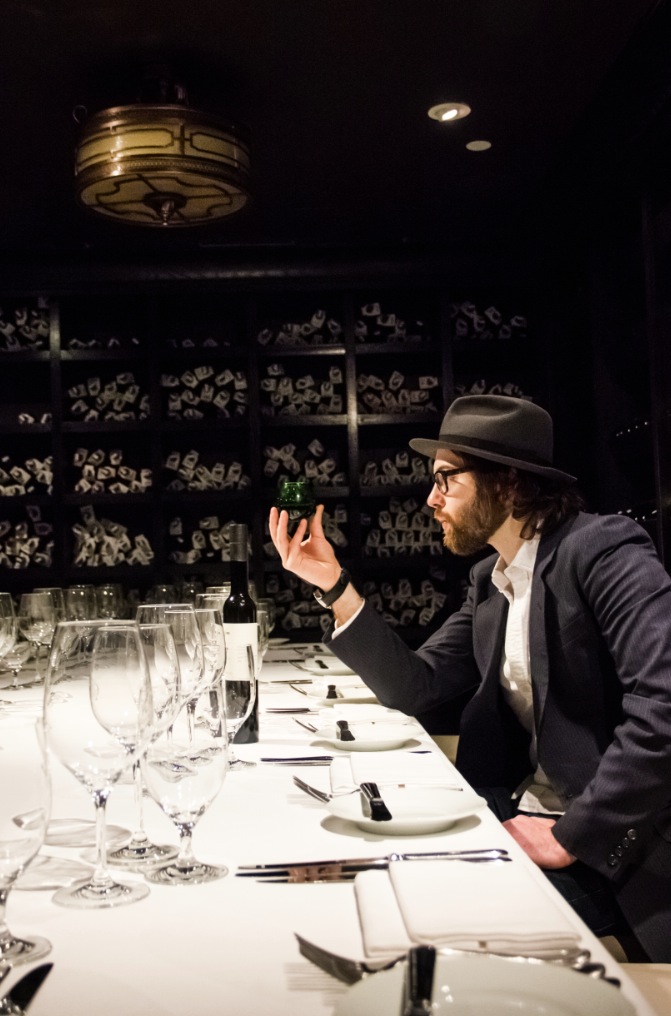If you live in Tuscany, chances are you’ve been called on by friends to help with their olive harvest or you have olive trees yourself. If you’re here for a visit, you are most likely enjoying flavorful Tuscan extra-virgin olive oil where it is grown and pressed. But what about our friends back in the United States? How can they enjoy the true flavors and be sure that they are getting authentic Tuscan oil? We talked to Nicholas Coleman, Chief Oleologist for Eataly, about his profession and his passion.

Meet Nicholas Coleman, Chief Oleologist for Eataly
Oonagh Stransky: Tell me about your relationship with Arezzo and the surrounding countryside.
Nicholas Coleman: In 2007 I embarked on a journey from the Arctic Circle in Finland down to the Sahara Desert in Morocco. It was my quest for truth, understanding and adventure, of the sort many people undertake in their early twenties. I happened to be in Italy during the olive harvest and was put in contact with Nadia Gasperini Rossi, from the ancient city of Arezzo. She took me under her wing, showed me how to hand-harvest, hand-clean and coddle olives from tree to mill in mint condition.
OS: What was the most difficult aspect of your training with the Italian Olive Oil Tasters Organization?
NC: I had spent years tasting hundreds of oils from around the world, so I had a pretty clear sense of identifying regional olive cultivars based on their smell, flavor and texture. Two weeks before the course, I abstained from alcohol, coffee, dairy and meat. I basically maintained a vegan diet. This process effectively neutralized my palate so I could sense the subtle nuances in oil.
OS: What is your role at Eataly in NYC?
NC: I spend most of my time at Eataly educating the public and staff about the 100+ extra virgin olive oils we carry. It’s the finest selection of single-estate mono-cultivar Italian oils in America. I also teach the master class at Lidia Bastianich’s culinary school, highlighting the unique organoleptic properties of oils from throughout Italy.
OS: In your opinion, what the American public’s most common misconception about olive oil?
NC: That olive oil has an indefinite shelf life!
OS: Given all the recent scandals about olive oil, how can consumers be sure they are getting good, healthy olive oil?
NC: Unfortunately, America is a dumping ground for the unwanted oils from the Mediterranean region. However, because of the Internet and certain boutique shops, it has never been easier to obtain world-class oil delivered right to your door. I’ve launched my own company, Grove and Vine, which sources world-class oil and air ships it directly to our subscribers’ doors. All of our bottles contain the primary factors: harvest date, olive cultivar and specific town, along with history of the producer, wine pairings and a regional recipe.
OS: I once had a phenomenal dessert prepared by an olive oil expert: pan di spagna, ricotta, whipped cream and new extra virgin olive oil. What is your favorite dessert with olive oil?
NC: I’ve had so many excellent desserts that incorporate olive oil. My favorite chef using olive oil is Brooks Headley, who was executive pastry chef at New York’s four-star Italian restaurant Del Posto. Nearly every dessert that came out of his kitchen utilized extra virgin olive oil in some capacity. Check out his book, Fancy Desserts.
OS: How many olive oils do you have on hand at home?
NC: I always have about 25 oils on hand at any given moment. Producers ship oil from around the world to get my opinion, sometimes professionally and others just as a friendly gesture. It’s an honor for me to receive their liquid gold, and I take great pride in providing them with my perspective.
OS: Tell me about your work with mono-cultivars. Do blends take a back seat?
NC: A wide variety of boutique, single-estate mono-cultivar oils have enriched the olive oil market over the past few years. How best to pair these oils with the appropriate cuisines and courses requires an understanding of their individual virtues. That being said, some of my favorite oils ever produced have been with regional field blends.
OS: What would you say to someone who wants to go into the business of producing olive oil?
NC: There are two ways to do it. Either buy land and then select the olive that thrives in that particular microclimate, or decide which type of olive you want to grow and then seek out land that allows that olive to thrive into a balanced fruit during the available growing season. Too many new producers “reverse engineer” an olive oil, and while they can produce extra virgin, their terroir never lets the olive express itself to peak perfection. Remember, the people of the Mediterranean spent hundreds of years finding which cultivars thrive best in an exact location. It’s best to do your homework and make sure you’re planting the correct olive tree.
OS: When it comes to pruning olive trees, some people dive in radically, others go for gentler approach. How do you see it?
NC: Pruning is an essential part of growing healthy fruit. It is considered by many to be a legitimate art form.
OS: What makes a good olive mill? New machines? Cleanliness? Traditional methods?
NC: I have a theory about this: I believe that being familiar with your gear is more important than having really good gear. I’ve had world-class oil that was produced in the now much-maligned traditional method of cold pressing olives with granite wheels and a physical hydraulic press. I’ve also had exceptional oil produced with state-of-the-art centrifugal modern extraction systems.








